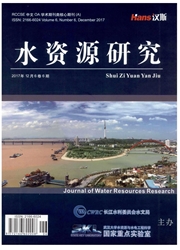

 中文摘要:
中文摘要:
针对汉江干流水质差、自净能力不足、生态流量难以保证等诸多生态问题,以汉江上游流域内调节性能最好的安康水库为调节手段,将河道基流、自净、冲淤平衡和生物生长的流量进行耦合得到不同生态径流过程作为生态目标。建立发电量最大、生态缺水量最小和兼顾发电和生态的多目标模型,分别采用GA和NSGA-Ⅱ求解结果表明:1)生态缺水量最小模型比发电量最大模型发电量减少了1%,生态保证率提高了5%,加入生态目标后,损失较少的发电量即可满足河道生态流量的现状需求;2)各单目标模型的结果落在了多目标Pareto曲线上,曲线的分段性特征论证了单、多目标结果的准确性和可靠性;3)以生态发电损益比k评价了各生态径流过程对发电的影响,推荐200%生态径流过程作为未来环境变化下的生态流量过程;4)制定了生态控制水位限制条件下的生态调度规则,为安康水库生态调度提供技术支撑。
 英文摘要:
英文摘要:
Ecological problems, such as poor water quality, lack of self-purification ability and difficulties in ensuring the ecological flow, have been appeared frequently in Hanjiang River Basin. Ankang reservoir, with the largest capacity in the upper reaches of Hanjiang River, was chosen as the case study in this paper. Different ecological flow processes were obtained according to the river base flow, self-purification, sedimentation balance and the biological growth, and were considered as the ecological target of reservoir operation. Single objective models maximized power generation and minimized ecological water shortage and a multi-objective model considering the two objectives were established and solved by Genetic algorithms (GA) and non-dominated sorting genetic algorithm (NSGA-II), respectively. It is shown that: 1) Compared with the operation model maximized power generation, the model minimized ecological water shortage reduced power generation by 1% and increased ecological guarantee rate by 5%, by which the present ecological requirements can be satisfied under sacrificed less power generation after taking account into ecological target; 2) Results of the single-objective model fall on the multi-objective Pareto curve, and the segmentation characteristics of the curve demonstrate the accuracy and reliability of the single and multi-objective results; 3) The impact of ecological runoff generation on power generation was evaluated by Loss-benefit ratio of ecology and power generation k, and 200% ecological runoff process was recommended as the ecological flow process under environmental change; 4) The ecological scheduling rules under the condition of ecological control water level are formulated, which provides technical support for intuitively and effectively guiding the ecological dispatching of Ankang reservoir.
 同期刊论文项目
同期刊论文项目
 同项目期刊论文
同项目期刊论文
 期刊信息
期刊信息
